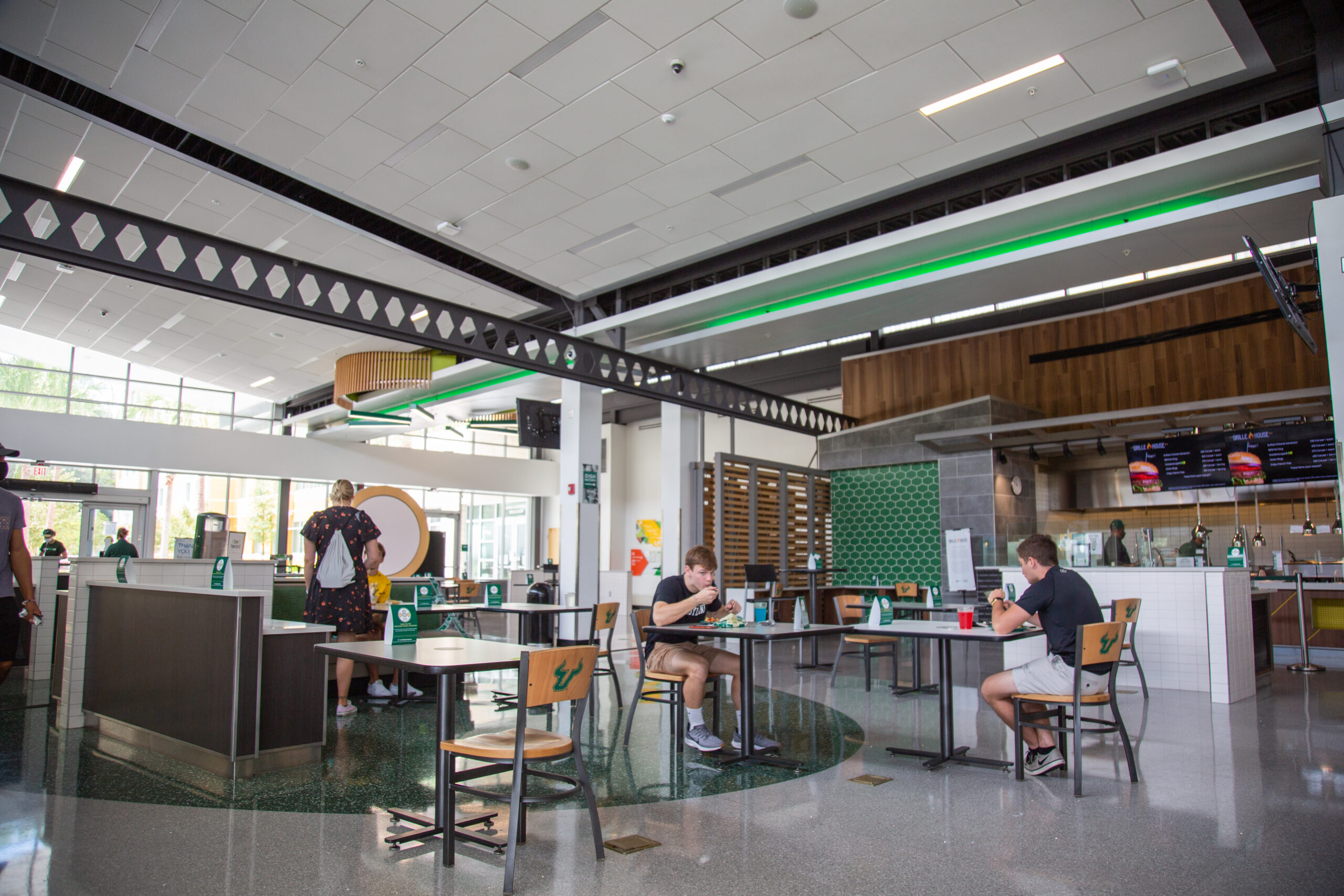The new reality of living and dining on campus

Amid the COVID-19 pandemic, Housing and Residential Education and Dining Services have set forth on the considerable task of reconfiguring spaces, training staff and setting up sanitization routines as students prepare to live the Bulls’ life and dine on campus.
Many of the newly established practices and installations — socially distancing spaces, mask requirements and plexiglass barriers — have already been put to practice as students moved on campus Aug. 16.
Not only did the pandemic impact guidelines and protocols in place at residence halls, but also the total occupancy for the fall semester.
“Our residency in St. Pete, maybe it’s 40 percent, not 90 percent. Tampa, I guess, we’re closer to 60 [percent],” said Board of Trustees (BOT) Vice Chair Stephanie Goforth regarding on-campus housing capacity for the fall semester during the BOT meeting Aug. 19.
Once students have settled into their rooms on campus, their lives will look a bit different than in past years, especially socially, as all Residential Education activity has moved entirely online, according to Assistant Vice President of Housing and Residential Education Ana Hernandez.
This includes community gatherings and hall activities, most often convened by residential assistants (RAs) to bring the residential community closer together.
In addition, no visitors or overnight guests will be allowed in dorm rooms. Communal spaces, laundry rooms and elevators may be restricted or have a limited capacity.
Only residents of an assigned building are permitted and have access to enter their building, and only one other building resident will be allowed as a guest in one’s assigned room.
In case a resident tests poitive for COVID-19 or has been been in contact with someone who tested positive, Housing and Residential Education has identified isolation spaces on the Tampa and St. Pete campuses to accommodate those students. About 250 beds have been reserved between campuses for any students who may have to self-isolate, which will leave the Tampa campus with 150 beds while the remaining 100 will be located at the St. Pete campus.
If the demand for isolation spaces is greater than its supply on the Tampa campus, then students will be shifted to an isolation space at the St. Pete campus.
“We are working very closely with [Student Health Services] with regards to the assessment of who would need to be isolated or go to the isolation location,” said Hernandez. “If it is deemed necessary for someone to go into isolation that is a residential student and if they are not able to safely return home to spend that isolation time, then those individuals would be sent to the isolation halls.”
Hernandez declined to comment on which buildings would serve as the isolation halls on either campus.
“We will be sharing that information with the students that have the need to relocate there,” said Hernandez.
Individuals who are isolated in these halls will be taken care of through “COVID Care Teams,” who will help satisfy medical, physical and mental health needs and help students stay connected with academic support.
Although social interaction will be limited in housing spaces, students will have more of an opportunity to enjoy time with peers in dining halls.
While Dining Services has also made changes similar to those of Housing and Residential Education to deter the spread of COVID-19, students will still be able to eat together in small groups when they arrive at the dining halls.
“So the tables have been reconfigured and the seats are six feet apart, but the way the tables are clustered, you still could enjoy meals with friends or with a friend,” said Jessica Cicalese, USF’s Dining Services marketing director.
Those who enter the dining hall will still have to socially distance from others, as well as wear a mask until they are seated at their tables to eat.
Selecting what food to order will also be a different routine. To-go orders will be encouraged by staff to those who walk through the door, and regardless of whether you’re dining in or out, food will most likely be prepackaged.
“We like to say ‘safe and speedy,’ and it’s really thorough, made on site, prepackaged foods, more like grab-and-go options,” said Cicalese. “In the past we did everything made-to-order where we customize on the spot.
“We have paused that type of service, so if someone still has food allergies, or if somebody cannot have an ingredient that is in already made or packaged item, we can absolutely make that for somebody, they just have to ask.”
As far as dining halls go, Juniper Dining, the Hub and Argos Exchange, including Flip Kitchen, Restaurant Rotation and Bay Coffee and Tea, will be open throughout the fall semester.
“All of our cashiers and our stations will have plexiglass coverings in between our employees and our guests to keep that contactless environment and our to-go options are definitely enhanced,” Cicalese said.
While the semester has just begun, the measures taken by USF Housing and USF Dining will definitely be tested as the volume of students on campus is increased in its facilities.
“The campus as a whole, including housing, has certainly invested in trying to create an environment that adheres to the CDC on health and safety guidelines and trying to create an environment that will help students be successful,” said Hernandez. “There’s been a significant investment that’s been made throughout the campus, including housing.”







